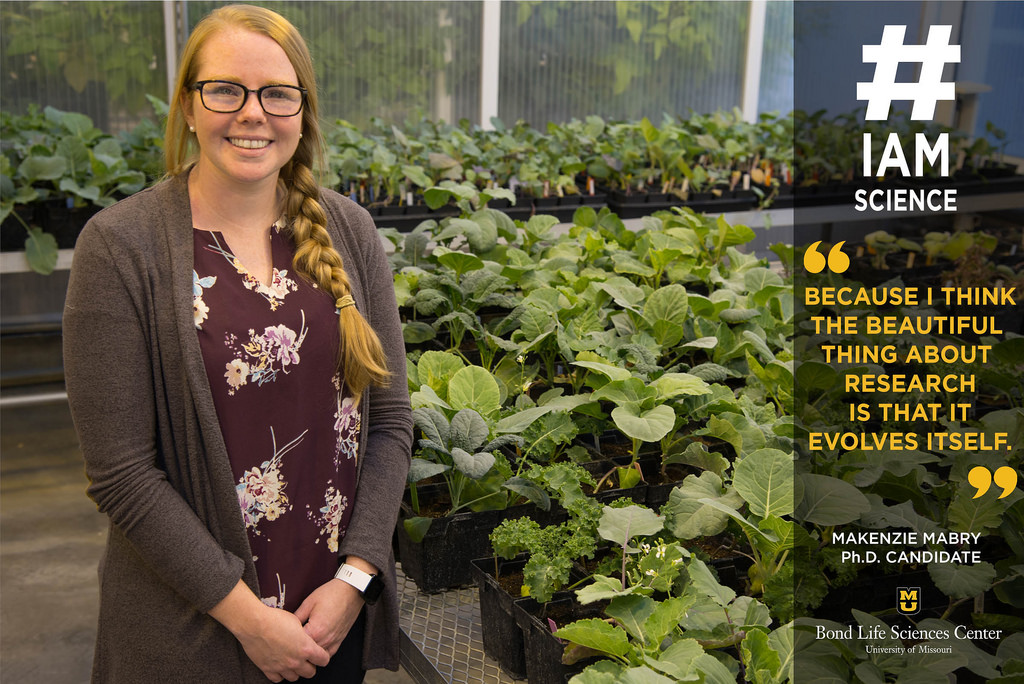Published on

Makenzie Mabry, a Ph.D. candidate, works in the Pires Lab in Bond LSC. | photo by Allison Scott, Bond LSC
For Makenzie Mabry, every day is a new puzzle when it comes to science.
That desire to solve new problems led her from wanting to be a veterinarian to considering much less cuddly focus in plants.
“I think the beautiful thing about research is that it evolves itself,” Mabry said.
Although she had an acceptance letter to vet school in tow, she altered her career path to work with a new passion: plants. That led her from California to the lab of Chris Pires at Bond LSC.
“I did all of my undergraduate studies [at San Diego State University] with a vet school plan,” Mabry said. “I took a class my senior year talking about plants — Taxonomy of California Plants — with a great professor [Dr. Michael Simpson], and he really sold me on how unique plants are. They break all the rules.”
With vet school no longer in her plans, Mabry volunteered to work with Dr. Simpson and learn as much about plants as she could.
“I was all ready for vet school and I emailed him a week after I was supposed to start to volunteer,” Mabry said.
After two years of volunteering, Mabry began working toward a master’s degree. During that time, she studied a plant native to her home state of California, Cryptantha. She also studied those which occur in Chile and Argentina by visiting both countries.
“That fueled my passion for research,” Mabry said.
However, it wasn’t until five years ago that Mabry met Chris Pires at a conference in Columbus, Ohio.
“He was very energetic and I had just started learning about polyploidy [which Pires studies]. Three years later, he somehow convinced me to move from California to Missouri,” Mabry said. “I really enjoy the work I’m doing here, and it was a good decision.”
Now as a third year in Pires’ lab at Bond LSC, Mabry uses Brassicales — a family of plants that range from papaya to Brussel sprouts — to explore the multiple genomes of plants. She enjoys her lab work, analyzing data and getting to know the plants.
“Learning the subtle differences between them — whether branches are really close together or their leaves are clustered — is key,” Mabry said. “Being able to account for those differences might mean a lot for being able to find genes that are responsible for them. You have to know what those differences are to know what genes are responsible for it.”
Specifically, Mabry tries to understand how polyploidy — when an organism duplicates their genome to end up with two or more sets of chromosomes — comes about and what impact it has on plant species.
“We want to prove that polyploidy can lead to adaptive variation,” Mabry said. “It can be two different species forming a hybrid, and they keep all of their chromosomes, or a single species that doesn’t go through reduction. That’s the major question our lab is focusing on.”
These extra chromosomes can potentially give a plant new traits that help them react better to the environment or reproduce better without compromising essential plant functions. There are complexities to polyploidy that make deciphering its existence difficult, though. For instance, they’re trying to uncover why certain genes are kept and others aren’t.
“There’s evidence that there’s one genome that’s dominant to the other,” Mabry said. “Polyploids have a larger gene size, so that helps them accommodate.”
And, as a result, Mabry’s research requires coding skills.
“If you want to be successful you need to know how to code. You at least need to know what data is put in and what comes out,” Mabry said. “In the next 10 years, I think it’s going to be even more of a part of the undergraduate curriculum – it’s going to have to be.”
Luckily, Mabry doesn’t work alone.
“I’m really grateful because I have four amazing undergrad students who work with me,” Mabry said. “I could not do it without them. They all have individual projects that they are responsible for and it is very rewarding to watch them succeed in writing grants, presenting their work, and getting results.”
Ultimately, though, the undergraduates she works with are a big reason why she envisions herself in academia.
“Mentoring — that’s what keeps me going every day,” Mabry said.